Visit Ta Prohm Temple In Angkor Complex When Travelling To Cambodia
Tuesday, January 23, 2024
Places to visit & things to do

What to do in Cambodia? When traveling to Cambodia, you cannot miss visiting famous temples including Ta Prohm temple in the Angkor complex. It's renowned for its wonderful combination of nature and architecture, as the temple is embraced by giant tree roots, creating a surreal and enchanting atmosphere. Let's explore with Autour Asia to learn more interesting things about this temple.
Table of Contents
I. Introduction General about Ta Prohm Temple
1. Some temple facts about Ta Prohm temple
Rising from the Cambodian jungle, Ta Prohm temple whispers tales of ancient wisdom. Built in 1186 AD, this majestic temple once hummed with Buddhist life, dedicated to Prajnaparamita, the embodiment of knowledge. Today, nature reclaims its own, with towering trees and vibrant foliage embracing the timeworn stones. Explore this captivating tapestry of ancient grandeur and verdant wilderness, best experienced in the golden light of early morning. Remember, a temple pass unlocks this extraordinary journey.
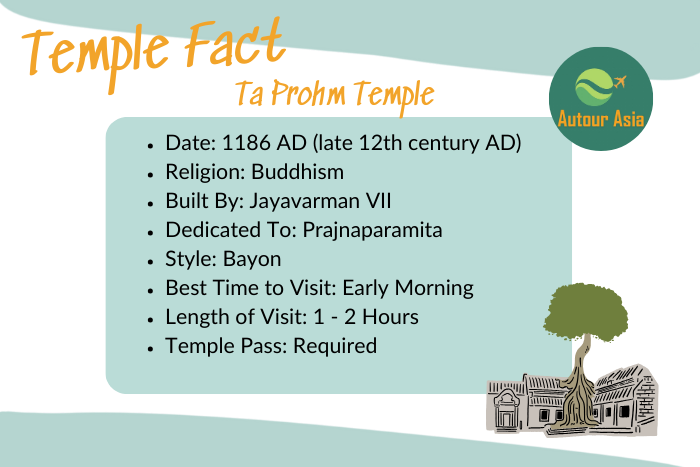
2. Legend of Ta Prohm Temple
The Ta Prohm temple harbors a truly extraordinary phenomenon - tree roots that defy conventional growth patterns by descending from the air rather than emerging from the ground. According to legend, wild birds transported seeds to the temple, where they fell and found a conducive environment for germination. An even more strange thing is that tree roots grow without any rules, but they can avoid the faces of the statues, making people think spiritually. This uniqueness and mystery have attracted many domestic and international tourists to visit here.
3. The architecture of Ta Prohm
The layout of Ta Prohm in the Angkor complex is similar to the "flat" temple form of Khmer temples, with 5 rectangular walls surrounding the central sacred shrine. Like most Khmer shrines, Ta Prohm faces East. The entire temple area is 1,000m long and 650m wide is now covered with trees. The temple is a large architectural building with functional areas and separate courtyards. If viewed from above, the temple is located within a perpendicular rectangular wall, with two entrances to the temple from the East and West, most visitors go to the temple. enter from the west. Ta Prohm includes 3 separate areas and 39 large and small towers with hundreds of bas-reliefs carved into the walls of the temple, which are artistic sculptures that could be images of the goddess Apsara, but the pictures have so far remained unanswered.

Take a look at:
>>> Get your guide to the Angkor Temple Complex in Cambodia
>>> Cambodia Visa application
>>> Get your guide to the Angkor Temple Complex in Cambodia
>>> Cambodia Visa application
II. History of the Ta Prohm temple
Rising from the heart of the Cambodian jungle, Ta Prohm Temple is an ethereal tapestry woven from ancient grandeur and verdant wilderness. Built in the late 12th century by the mighty Khmer King Jayavarman VII, it originally bore the name Rajavihara – "Monastery of the King." This vast complex flourished like a Mahayana Buddhist university, echoing with the sounds of chanting and the pulse of the pursuit of knowledge. Its walls are decorated with intricate decorative carvings that tell stories of Buddhist gods and myths. This is also the place to worship the Queen Mother (King Jayavarman VII's mother) and is a testament to the kingdom's devotion and the king's filial piety towards his revered mother.
Nevertheless, with the decline of the Khmer Empire in the 15th century, the site completely changed. Rajavihara was deserted, succumbing to the inexorable embrace of nature. Towering kapok trees, their roots like ancient serpents, entwined with the sandstone, their emerald leaves shrouding the once-majestic edifice. Vines crept through decaying courtyards, and silence replaced the vibrant hum of monastic life. The jungle had reclaimed its own, transforming Rajavihara into a hauntingly beautiful tableau of ruins and foliage.

Centuries passed, and the Cambodia Ta Prohm seemed to be forgotten and not mentioned much anymore It wasn't until the late 19th century that it re-emerged from the verdant labyrinth, rechristened Ta Prohm – "Ancestor Brahma". This evocative name echoed with the temple's forgotten grandeur and its mystical aura. This architectural wonder has been declared a World Heritage Site by UNESCO, where history and nature coexist in breathtaking harmony.
III. What’s special about the Ta Prohm Temple in Cambodia?
1. Tung Tree Area
The Tung tree area is one of the most popular spots in Ta Prohm Temple, Angkor Wat, Cambodia. The area is named after the giant kapok trees (Ceiba pentandra) that have grown over the temple ruins, their massive roots enveloping the ancient stone structures in a dramatic display of nature's power. The most famous of these trees is the "Tomb Raider Tree," named after its appearance in the 2001 film. The roots of this tree protrude and extend out of the eastern wall inside the temple, creating an impressive scene and is the most popular tourist attraction in the temple.
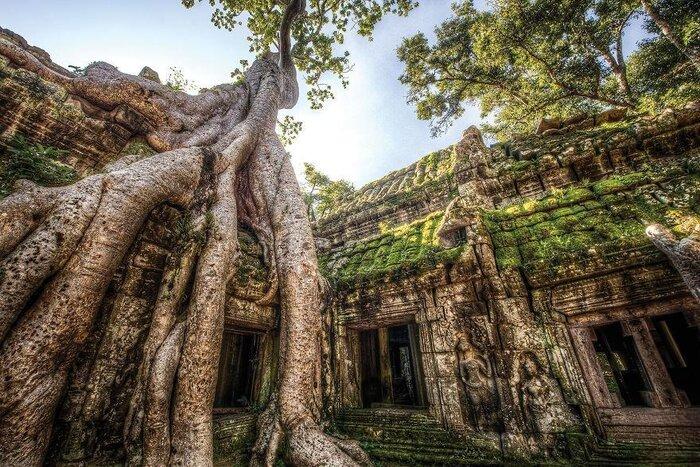
The Tung Tree area is a fascinating place to explore and it's easy to see why it's one of the most popular spots in Ta Prohm. The combination of ancient ruins and towering trees creates a truly unique and atmospheric setting. Would you like to know more about the history of Ta Prohm or the kapok trees that grow there?
2. Knia Tree Area in Ta Prohm temple
While the giant kapok tree dominates Ta Prohm's Tung Tree Area, another equally captivating scene awaits within the temple's eastern enclosure: the Knia Tree Area. Here, a colossal knia tree, known for its intricately woven aerial roots, reigns supreme. Its gnarled branches and roots stretch over ancient rocks, creating impressive canopies, making it impossible for visitors to take their eyes off them. But the special thing is that they grow away from the faces of the reliefs. The massive, tentacle-like roots twist and weave around the temple doorways and doorways, some even piercing through stone, their ancient resilience contrasting with the weathered grandeur of the ruins. This perfect combination of nature and history makes the Knia Tree Area a popular stop for all visitors who want to learn about Ta Prohm’s past.
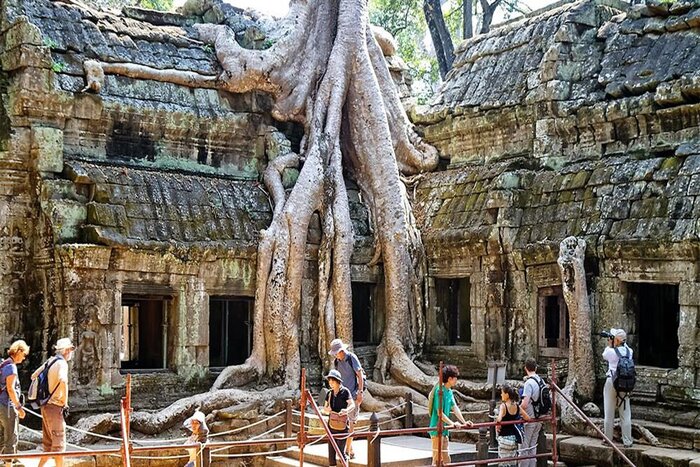
Maybe you're interested: What to do in Siem Reap for 3 days?
3. The scenery of the Tomb Raider Area in Cambodia Ta Prohm
Stepping through the jungle-covered entrance of Ta Prohm in Cambodia, you not only enter an ancient temple but also enter a living, breathing landscape. Imagine towering gates covered with emerald vines, and sandstone faces carved with mysterious smiles. The air hums with the whispers of history and the calls of strange birds.
Cottonwood trees, their giant trunks like ancient snakes, their roots threading through crumbling walls and broken doorways. Fig trees, their aerial roots cascading like curtains of leaves, tower over crumbling towers and overgrown galleries. This is the scene that captivated Lara Croft and the world in the 2001 movie “Tomb Raider.” Every corner seems to contain a forgotten secret. It is seen as an adventurer's destination, a photographer's paradise, and a reminder that even in the ruins of empires, beauty and wonder can still exist.
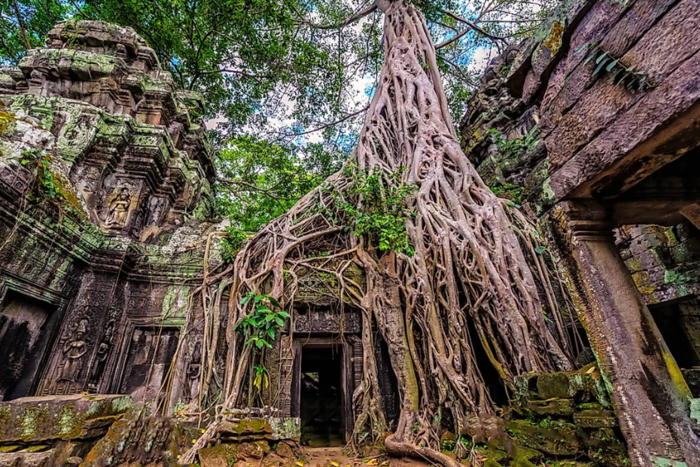
4. Central Sanctuary
The main hall of Ta Prohm temple in Cambodia is a large hall located in the center of the temple built in the 12th century by King Jayavarman VII, initially dedicated to worshiping Mahayana Buddhism. It is built in the classic Khmer architectural style, with a high pyramidal dome in the center and surrounded by four high walls, about 50 meters long and about 40 meters wide.
Inside the main hall, there is a tall stone pillar in the center, called a linga. Linga is a symbol of Shiva, one of the supreme gods of Hinduism. In addition, visitors can admire the elaborate carvings on the walls and stone pillars, often depicting images of Buddha, Hindu gods, and scenes of ancient Khmer people's lives.
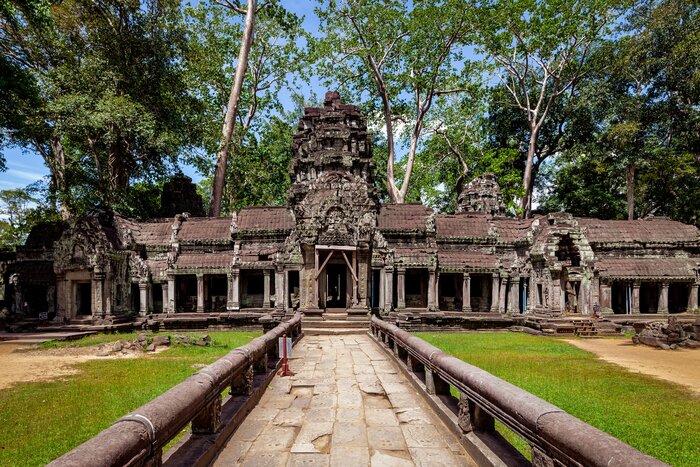
In particular, the main hall of Ta Prohm temple also has a large stone Buddha statue, about 3 meters high. This statue is meticulously carved, with soft and delicate lines. However, the main hall of Ta Prohm temple is also the place most heavily damaged by time and nature. The walls and stone columns were covered with moss, and many of the carvings were damaged. However, the main hall of Ta Prohm in the Angkor Complex is still one of the most attractive attractions of the Angkor Complex. The temple bears the mark of time and nature
IV. Some useful notes for your travel to Ta Prohm
- Respect the relic: Follow the rules and guidelines to preserve the site. Avoid touching or climbing on the temple structures, and respect any roped-off areas.
- Tips: The best time to visit Ta Prohm is early in the morning or late in the afternoon when the crowds are smaller. If you want to avoid the crowds altogether, you can visit during the rainy season (May to October). However, it is important to be aware that the temple can be slippery when it is wet.
- Nearly attraction: After visiting Ta Prohm, explore other nearby temples in the Angkor complex, such as Angkor Wat, Bayon, and Banteay Kdei.
- Smart choice: Wear comfortable clothing and sturdy footwear suitable for walking and climbing. Carry water, sunscreen, and insect repellent, especially during the hot and humid months.
In conclusion, Ta Prohm is a place where history and ecology intertwine, creating a landscape of breathtaking beauty and haunting mystique. So, if you seek a glimpse into the soul of Angkor, look beyond the grand avenues and towering spires. Venture into the embrace of the jungle, and let Ta Prohm transport you to a world where time stands still and nature reclaims its own. With the information suggested above, Autour Asia believes that you will have the best preparation for your trip. Hope your trip will be wonderful.
You might be attracted to this:
>>> Siem Reap Travel Guide
>>> Cambodia adventure tours
>>> Cambodia Packages Tours
>>> Please contact AUTOUR ASIA, best travel agency in Asia
>>> Siem Reap Travel Guide
>>> Cambodia adventure tours
>>> Cambodia Packages Tours
>>> Please contact AUTOUR ASIA, best travel agency in Asia
Related travel guide
Other similar articles
CUSTOMIZABLE BY LOCAL EXPERTS
Personalized trip at the original price!
REFUND GUARANTEE
We believe in our work and promise to give you money back.
GOOD PRICE / QUALITY
95% satisfied more than expected!
24/7 LOCAL SUPPORT
We are always available online to provide assistance at any time.
Most read articles
Autour Asia is highly recommended on
Embracing the mission of "Satisfied more than expected" and providing authentic experiences, we have received numerous recommendations on reputable travel forums:























